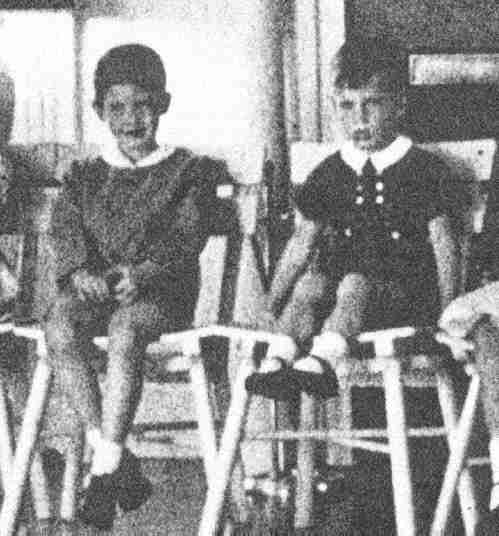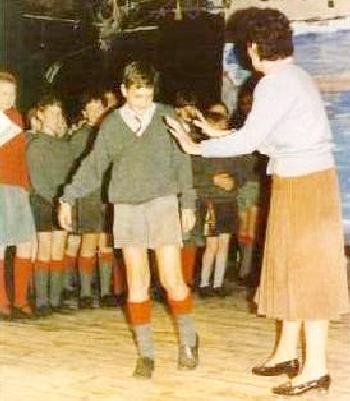
Figure 1.--Boys at dancing classes commonly dressed up in short pants suits. Younger boy might wear Eton suits with Peter Pan collars. The boy on the right wears a little boy button outfit with white socks and strap shoes.

Learning to dance has been a nettlesome issue for many boys, much more interested in baseball and football. The girls looked forward with enthusiasm to dance class. Many boys, however, were sent off to dancing school only after considerable resistance to learn the box step. But learning the social graces, as any mother can tell you, was one of the necessary steps in growing up. Mothers for there part could never undrstand why boys objected so much to dancing lessons. After all, they remember the experience as girls and they had thoroughly enjoyed it. Many boys, however, often remember the experience with considerable distaste. Formal dancing lessons have become less common in the modern era. Many boys do, however, receive dancing lessons at school. The private schools make a special effort in this area, but dancing lessons are also offered at many state schools.
Boys often at mom's urging have participated in various dance programs. For most boys it was for much of the 20th century learing social dancing--the joys of the box step for the more adventuresome the Fox Trot. By the end of the 20th century this had become less common. Other boys participated in more formal fine arts or ethnic dancing programs. Relatively few boys have attemded dancing school to learn classical dance, but many boys have attended dancing school to learn social dancing. There were many things about the experience boys objected to. One was having to wash and dress up, often in a short pants suit. Then there was habing to put up with all those giggling girls. It was all too much for a red-blooded American boy to tolerate. He wanted to be playing baseball, but had to instead spend an entire afternoon--actually dancing with a girl!
Many boys do, however, receive dancing lessons at school. The private schools make a special effort in this area, but dancing lessons are also offered at many state schools. Usually they were not very popular, especially after the first few years at school. Many of us who went to state schools remember the dancing lessons held in the gym during physical education class. The girls loved the idea, the boys hated it.

Figure 2.--The children at this English preparatory school are receiving dancing lessons. They are wearing their school uniforms. |
Private schools often give great emphasis to the social graces. Thus they have traditionally placed a greater emphasis on dancing lessons than private schools. Patterns vary over time and between coutries. There have been changes in recent years. Dancing lessons at British preparatory schools (elementary level private schools) were rare in the 1950s. Elementary age children, even youbnger teenagers did not normally go to dances. Boys generally received dancing lessons when they went on their public schools (secondary level private school). By the 1980s, almost all preparatory schools provide dancing lessons to the children. Often the girls are given lessons in ballet and other types of dance. Usually the boys do not participate, but there are some intrepid souls at a few schools. The boys are given lessons innsocial dancing and in some schools folk dancing. Scottish boys, for example, are taught Highland dancing. American boys learn square dancing. Even the social dancing is not well received by usually well-behaved boys atvprivate school. One groups of boy at a unidetified school virtually rebelled aginst a strict dancing master, Mr. William de Rham in the 1970s.
State schools do not give the same attentuion to dancing as private schools. They often do, however, provide some dance inhstruction. American elementary schools often do square dancing. Secondary schools in the 1950s and 60s usually did social dancing in the gym classes. Dancing has changed so much in recent years, HBC is no longer sure if schools still provide lessons in the traditional dances like the box step. Hpefully HBC readers can provide some guidance here.
Dancing masters for centuries have been forbidding figures. Luminary dancing masters, Italians Guglielmo ??breo and Antonio Cornazano dazeled 15th century Italy. In our modern era, 19th century dancing masters were renowned figures--Henri Cellarius (Paris), Allen Dodworth (New York), and Larenzo Papanti (Boston). Dancing masters throughout the ages have had the same high-minded and fiery tempers. They have been neither ladies' men or mens' men, but rather mannered men, devoted to discipline and decorum as well as dance itself. Dancing masters have rarely been pictured smiling. Perhaps this is because in their eyes, there has been little to smile about. They have had to view over the years, what they view as steadily degenerating generations.
Navigate the Historic Boys' Clothing Web Site:
[Return to the Main dance page]
[Introduction]
[Activities]
[Bibliographies]
[Biographies]
[Chronologies]
[Contributions]
[Countries]
[Style Index]
[Boys' Clothing Home]
Navigate the Historic Boys' Clothing Web chronological pages:
[The 1900s]
[The 1910s]
[The 1920s]
[The 1930s]
[Thw 1940s]
[The 1950s]
[The 1960s]
[The 1970s]
[The 1980s]
[The 1990s]
Navigate the Historic Boys' Clothing Web style pages:
[Kilts]
[Caps]
[Sailor hats]
[Lederhosen]
[Sailor hats]
